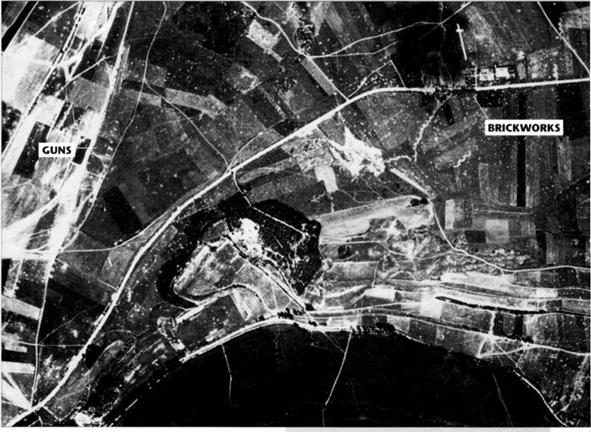Making a montage of testimony of Captain Roy Brown, Oliver LeBoutillier, Lieutenants R A Wood, J M Prentice, J A Wiltshire and Sergeant Gavin Darbyshire, plus Gunner George Ridgway, it is reasonably certain that the following occurred.
Arthur Roy Brown had been in France since April 1917 and been awarded the DSC in October for having shot down four German aircraft. He was on leave over the winter but returned to 9 Naval as a flight commander in mid – February 1918. Since then he had raised his score of combat victories to nine. In short, he was an experienced fighter pilot.
Manfred von Richthofen had survived as a tighter pilot for eighteen months, approximately thirteen and a half of which had been on active duty at the front. Keeping a sharp look-out, having speedy reactions, keeping the dice loaded in his favour and a measure of good luck had kept him alive. On this day, the reduced side vision due to his special flying goggles would have forced him to turn his aeroplane in addition to his head to check his tail. During the elapsed time of Browns dive and approach he would have done so several times. It is quite likely that Brown saw von Richthofen make a check to the left rear as, with an appropriate deflection angle, he aligned his gun-sights on the Triplane. Whatever happened Brown’s strategy worked well. Von Richthofen, with his vision to the left impeded by the sun, the haze and his goggles, tailed to see Brown diving on him. Brown later wrote: 4 got a long burst into him’ – which by WW1 definition was five to seven seconds. In fact. Brown’s strategy worked too well, for, during his low, high-speed pass from out of the haze, through the wisps of river mist and back into the haze again, he was not visible for very long to anybody who was looking upwards or horizontally to the south-east. Apart from a working party down in the valley, only those who were high enough up to see downwards over the Ridge at a steep angle through the mist, and who were looking that way at the right moment, saw the entire interception.
During such a burst of fire the Camel would have moved somewhere between 175 and 245 yards closer to the Triplane. Allowing distance for collision avoidance, it would appear by calculation that Brown was 300 to 350 yards away from his target when he pressed the triggers. To close the range to the normal 50 yards before firing would have taken seven or eight more vital seconds and could easily have cost Lieutenant May his life. From the tactics employed by Brown, it would appear that his plan was for May to use his superior speed to escape whilst von Richthofen was occupied countering the sudden new danger that Brown posed.
Up on the top of the Ridge just across the road from the Sainte Colette FOB, Private Emery, a trained and proficient anti-aircraft machine gunner, assisted by Private Jeffrey, was gazing upwards at the distant air battle now scattered between Cerisy and Sailly Laurette. Both were hoping that some ‘trade’ would come their way. They prepared their Lewis gun just in case. Together with Lieutenant Wood, in his trench on the brow of the Ridge overlooking Vaux-sur – Somme, they had a clear view to the south around the patches of mist. Gunner Ridgway, who was 20 feet up the Sainte Colette brickwork’s chimney (which in 1918 was not in the present-day
|
Scene of the final moment of the Baron’s Last flight, 21 April 1918
|
|
|
|
|
|
 |
|
|
|
|
|
|
|
|

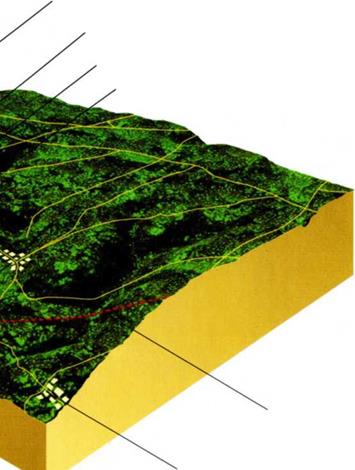
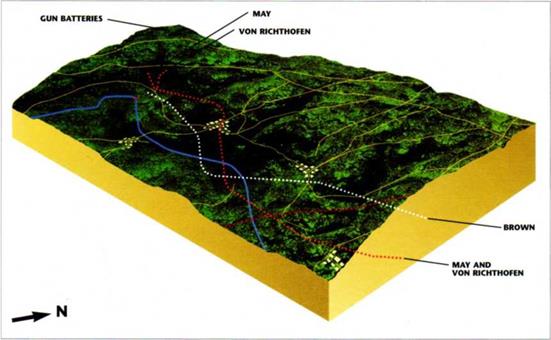
May, pursued by Von Richthofen, heads along the and curves southwards to have the sun behind him as
canal towards Vaux-Sur-Somme. Brown dives down he makes his attack on the red Triplane west of Vaux.
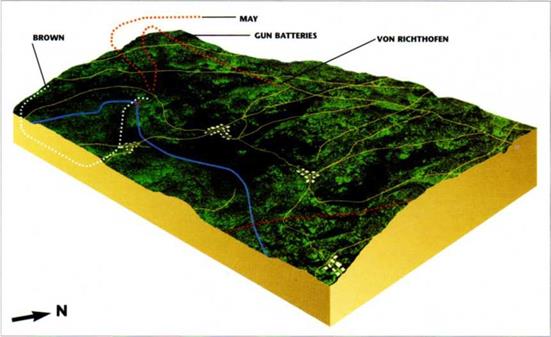
Roy Brown breaks away to the south and begins a climbing turn over the Ridge by Corbie. May pulls up over the Ridge as Von Richthofen continues the chase for a few moments but with both guns now
inoperable, he turns east, by the Australian guns and, hit as he pulls back over the Ridge, attempts a crash landing by the Saint Colette Brickworks.
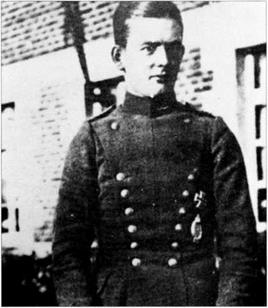
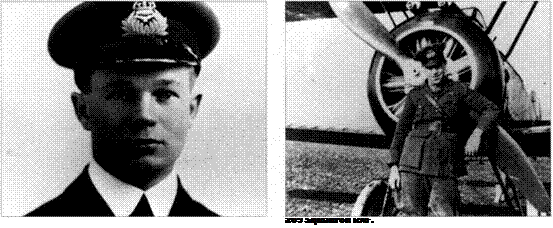
Top right: Lieutenant W j Mackenzie, 209 Squadron RAF.
Left: Leutnant Joachim Wolff, Jasta 11.
Above: Captain О Le Boutillier, 209 Squadron RAF.
position, but further forwards, closer to the road) was mending telephone wires. (Ridgway was not. as sometimes stated, on TOE of the chimney, nor half way up a telegraph pole.) He had the best view of all. He could not only see above and beyond Vaux but also down into the valley beside it. All four men watched the third aeroplane approach from the south-east in a 45° dive. Except for Privates Emery and Jeffrey, who were too low down, they saw the third aeroplane open fire on the German. Due to later reports that the leading aeroplane was an RES from 3 Squadron AFC’, it was doubtful that all or any of the watchers identified the types or even the nationalities correctly in the early stages.
In late 1937 and early 1938 John Column was in touch with W J G Shankland, from Greenvale,
Victoria, who was a gunner with the 27th Battery, A1F in 191S. In correspondence concerning whether or not there was a third aircraft in the vicinity, as he stood watching the scene facing south, he stated:
I say quite definitely that there was [a third aeroplane]… British and German machines [were] engaged in a dog-fight over the enemy lines and whilst manoeuvring for position they disappeared below the crest of the slope on which we had our battery position. In a few minutes a Sopwith Camel plane, flying very low, came into view a little to the right of the brickworks which were situated on the top of the slope and about 4-500 yards to our right and
slightly in advance of our position. Sitting hard on the Camel’s tail was Richthofen in a red triplane, followed closely by another Camel. The first Britisher seemed to me to ground his wheels, and hesitate as if about to land and then continued on across the valley to safety. Opposite the brickworks the German rose sharply to 200 feet or so. began a right hand turn and nose dived into the ground.
I was one of the first 20 or 30 to reach the scene of the crash, and can still clearly see the tall, closely cropped fair-haired Baron lying on his back amongst the ruins of his plane.
Once again we have the distant slant view by Shankland, and from Ins position it is probable that his feeling that May had attempted to land his machine was due to the fact that the Camel did not climb to escape but flew parallel to the ground as the Gunner viewed it, and assumed it was trying to land. An optical illusion?
In one of Mays later accounts of the action he confirmed that at times during the chase down the valley he was so low he could have gone no lower. This supports the witnesses.
There is another account of a witness seeing
Mays wheels touch the ground. This came from E ETrinder, an observer with the 31st Battalion AIF. writing to Column from his home in Brisbane in January 1938. Trinder had been watching the whole action through a pair of Zeiss binoculars, for his job was to report all daily happenings and movements on the Battalion sector and noting map references etc. This morning his FOP was situated on the spur of Corbie |Morlancourt| Ridge overlooking (ie: from where he could see through his binoculars) both the villages ot’Vaire – sous-Corbie, which was held by his battalion, and Le Hamel, occupied by the Germans.
… I watched their progress over the British side of the lines, both planes [sic] firing at intervals, when I was astonished to notice both planes change direction towards our OP. As they came close the British marked plane was only one length and a half ahead of the German plane which was shepherding the British plane towards the ground. As they came within 40 yards of the OP the British pilot endeavoured to land, his wheels on the plane touched the ground on two occasions, but he had too much speed to land, as he certainly would have capsized. He went over the side of the hill for a few hundred feet. The German was on his tail during this landing movement; the British plane then skimmed the grass and rising went directly towards a wood, which was 150 yards from the OP. Immediately on
reaching the wood – the planes were no higher than 50 feet – a burst of bullets from a Lewis gun situated in the wood was fired and the German plane momentarily wobbled and then crashed to the ground.
The British plane flew straight on and passed over the town of Corbie. I can honestly say they were the only two planes that were seen over the Ridge that morning, and who fired the burst from that Lewis gun I cannot say. If I had known who the pilot of the red plane was at that particular moment he crashed, I would have certainly broke a record to be in for a souvenir.
This seems yet another case of the short appearance of Browns Camel below in the valley being hidden by the lip of the Ridge from a viewer higher up. When combined with the mist over the valley, the sun to the south, we can see quite clearly how people standing in different locations and concentrating on the two main antagonists can report seeing contradictory things if interpreted as applying to the chase as a whole.
Another Australian correspondent with John Coltman in late 1937 was Jack O’Rourke, also from Brisbane. Being in another spot, apparently about a mile further to the east than Trinder, he was most emphatic that the second Camel did the damage:
…anyone suggesting that there was not a third plane in Richthofen’s fatal dive is very definitely wrong. The third plane was on Richthofen’s tail quite long enough to have caused this great airman to go to his death.
Left: The church at Vaux-sur-Somme taken in July 1996; May nearly led von Richthofen into the tower after the chase along the canal and coming out of the mist above the water.
Below: The wooded slope of the Morlancourt Ridge (facing north) taken in 1918, as the river turns from north-west to south; to the right is the marshy flooded area and Corbie is in the foreground. (The canal is just out of view to the right.)
I was standing not more than 50 yards from where the pursued Camel flattened out from its life or death dive and could plainly see the pilot looking round to see if Richthofen was following. On looking up for Richthofen I found that his guns were not firing and that he seemed to have changed the angle of his dive and that he had another plane on his tail. His machine seemed to wobble and considerably slacken its speed as the other British plane left him and returned to the dog-fight. This would naturally convey to one that the second British pilot was satisfied he had got his man.
Major H C Rourke MC was another of Columns correspondents, whilst serving at the Royal Military College, Duntroon, Australia in 1937. He was atop the Morlancourt Ridge, east of the brickworks, on the 21st, with the 27th Field Battery A IF:
I was standing in the mess dug-out on which was mounted an AA Lewis gun. After the battle had been going on for some minutes I saw a Camel dive towards the ground. It was followed at once by the red triplane. As they got near the ground they were both obscured by trees and a ridge to the south-east of the battery. Shortly afterwards three planes (two Camels and the red triplane) came into view from the south-east and commenced chasing one another round the trees. The triplane was engaged by a large number of ground AA Lewis guns including my gun, whenever it was safe to fire. One Camel disappeared early and Richthofen appeared to be getting the better of the other. Finally the last Camel appeared to break off the fighting and fly off in the direction of the aerodrome.
Richthofen manoeuvred his plane round the trees for a short time, as if looking for his opponent, and then flew due west straight up the Corbie ridge, generally above the Corbie-Bray road. He was flying about 200 feet above the ground and was being engaged by a large number of Lewis guns. As he passed over the ridge the nose of the machine was almost pointing straight up in the air. He then dived suddenly and appeared to crash nose first.
Up in the sky from a distant slant view, LeBoutillier saw Brown make his attack exactly as described on the plaque in the military club in Toronto where the Triplane’s seat, etc, is on view. LeBoutillier stated that he saw Browns tracer strike the Triplane but he did not say where, presumably because the slant view would not have allowed him certainty. Apparently he said in later life that he saw the bullets strike the cockpit area, but one has to wonder if by that time he was adjusting his view to fit the known facts? At the very least the tracer passed by close enough for von Richthofen to see the trails of smoke.
Lieutenant Wood heard shouts from the field kitchen in the trees on the slope below him. Bullets from the air had struck the mobile stove; one of them had holed the stew-pot and part of his platoon’s mid-day meal was streaming out through it onto the ground. The hungry men must have noticed that the third aeroplane was facing in their direction at that time for they cursed its pilot roundly and in no uncertain terms! This is further confirmation that Brown attacked the Triplane from the south-east; that is on its left side.
As no bullet holes were later found in the tail or the rear of the fuselage, on the basis of probability it may be presumed that some of Brown s bullets hit the Triplane s wings and that von Richthofen saw the smoke of the tracer from the others pass by. After the forced landing, one soldier who looked at the Triplane stated that the interplane struts on one side had suffered damage. Unfortunately he did not clarify which side or how he thought the damage had occurred. Whether the Baron heard the Rak-ak-ak sound, saw tracer smoke, heard/saw bullet holes or was hit towards the end of Brown’s long burst, his subsequent behaviour establishes that he believed he was being attacked from the left. Even if he saw no indication of the whereabouts of his attacker, the position of the sun to his left and the Ridge face to his right heavily favoured the left.
Von Richthofen’s immediate and ingrained reaction would have been to turn and face his attacker who would logically be somewhere up there in the sun on the left and who was most likely correcting his aim at that very moment. To hesitate meant to be shot down. People who have claimed to have fought against him in combat all confirm how quick his reactions were. The first shot fired in his direction and he was gone.
However, on this occasion, being too low down to roll over and dive away, plus the risk of a collision if he turned left to face the attack, he ‘broke’ sharply to the right. There were two good reasons for this ‘breaking’ direction. The first was that it would put more distance between himself and the bullets coming his way. The second one was also the reason why Brown stopped firing and began turning left – to avoid the mid-air collision. Other than stories which depend entirely and absolutely upon bullet holes which never existed, no information has been found to gainsay LeBoutillier who claims to have seen the “break*. Whilst von Richthofen was occupied, May had been handed an excellent chance to escape. Unfortunately he did not see the chance and continued to zig-zag.
The topography, prudence and combat technique dictated that Brown make a gradual turn to the south-west (his left) immediately after firing. In this way he would not present himself as a target to the Triplane pilot and could lose his excess speed on his way up and round the south of Corbie before continuing into a right-hand turn to the north and home. If May was then still in danger from the Triplane, he would yet be in a good position to spot the two aircraft and engage the German again as they dropped down the northern side of the Ridge. It should be noted however that it is not easy to relocate an aircraft once it has been lost from sight. May was in a camouflaged machine but even a distant red aeroplane would not be that easy to find, always provided Brown was looking in exactly the right direction and distance. Like forced-landing drill – never take your eyes off the field selected or you’ll never find it again.
Oliver LeBoutillier later confirmed that Brown did as described above and pointed out that during his long, gradual climbing turn to the left. Brown’s wings would have obscured the view of the Triplane and he would not have seen what followed. That Brown believed that he had wounded the German pilot, is indicated by his reports and actions later that day. Unfortunately, having lost sight of the Triplane, it would not be so easy for Brown to find it again as might be imagined.
Both of Brown’s combat reports (he made out two due to reasons which will be explained later) state: ‘He went down vertical.’ But unfortunately neither one of them says when or beginning from where. One thing is certain, it was not immediately after; the Triplane was not high enough for it to do so. His flying log book entry is equally silent on this point. According to LeBoutillier the descent followed some time afterwards. The other witnesses to Browns attack agree with that.
If von Richthofen had been killed by Brown’s long burst, the red Triplane would have crashed beside the river between Vaux-sur- Somme and Corbie, or certainly on the southern slope of the Ridge. Its engine would probably have still been running at normal power. A wounded von Richthofen could recover control and fly for some time; how long and how well was another matter. Those who query whether he was hit at this stage, either by Brown (who in any event was the wrong side of the Triplane to inflict the mortal wound) or from ground fire from the Ridge, must explain why the Baron did not immediately turn south to south-east, towards the German lines, rather than face the climb over the Ridge.
Wounded or untouched, as may be, whilst von Richthofen was completing his evasive action, he would already have been looking for his attacker. He would have noted that the aircraft which had caught him by surprise had overshot at high speed and would not be back for a while. Assuming that the Baron had mistaken his ground position, he would have believed that the heavily defended zone between Vaux and Corbie was yet a couple of miles away. The only Allied airfield around was the one north of Vaux, formerly used by 3 AFC as a landing ground, but which had been evacuated three weeks earlier. Apart from the now departed Camel which had attacked him, there was no sign and not much likelihood of any unfriendly activity. The Camel that he had been about to despatch was still zig-zagging away. It was further ahead than before but not too far to catch. There was time for one more try. The continued zigzagging agrees with Lieutenant May’s later statement that he did not see Brown’s attempt to rescue him.
On the basis of airmanship, a pilot of Brown’s calibre would not have made unnecessary manoeuvres in an aeroplane close to self – disintegrating speed. If he was doing anything at that moment other than sweating, it was most probably trying to check May’s present situation. This is supported by Lieutenant J Quinlan on the Morlancourt Ridge who reported having seen an aeroplane travelling west about half a mile beyond the far side of the river. The probability is that after Brown’s Camel had slowed down enough to restore normal control pressures, he looked back to his right. In the time taken to do this, he would have travelled about one mile. May would have travelled less than that, but to find May’s olive-brown Camel and the red German Triplane against a dark background. Brown needed first to know approximately where they were. Looking into three-dimensional space is one thing, finding something is another.
Whilst Brown was distracting von Richthofen from May, Lieutenant Mellersh had succeeded in escaping from the two Triplanes which had forced him down to hedge-hopping height. All that is known of Mellersh’s movements from then onwards is that, as he passed near Corbie on his way home, he saw a red Triplane crash nearby. He did not say to his right or to his left. He then looked upwards and saw Brown’s streamered Camel above him. However, based on LeBoutillier s statement that Mellersh was flying ahead of him and off to his right, one has to assume from this that Mellersh had to be south of the river and if he was indeed flying north-west in the direction of Bertangles. then the Triplane must have been off to his right and within his view.
The total elapsed time between Brown ceasing fire on the Triplane and Mellersh seeing him overhead would have been about 30 seconds, depending on exactly where Mellersh
was.
There would be nothing unusual for an aeroplane with a severely wounded pilot to fly, under control, for some time before crashing. There were many cases during the war of a pilot dying of wounds within minutes of making a successful landing. It would have been nothing really extraordinary for Brown to catch sight of the red Triplane in a steep descent about 30 seconds after he had fired on it and about half a mile from the place where he had done so.
Although neither of Brown’s combat reports nor log book mentions the subject, he later affirmed that he had seen the red Triplane crash at Sainte Colette. To quote:‘May saw it, Mellersh saw it and I saw it.’ If‘it’ included the steep angle of the Triplane’s initial descent and not just the cloud of dust which followed, the source of the phrase: ‘He went down vertical,’ is explained. Brown never publicly clarified exactly what he saw and there is no record that he was ever asked to do so.
As Jasta 11 pilot, Leutnant Richard Wenzl, flew past Corbie and Hamelet on his way back to Сарру, he noticed a small aeroplane on the ground. When combined with von Richthofen’s failure to return and Leutnant Wolff’s sighting of him low down in the same general area, he recalled that the small aeroplane might have been red in colour. The suspicion arose that something unfortunate must have befallen their leader.
Upon hearing this unwelcome news, Hauptmann Willi Reinhard immediately ordered three aircraft to be refuelled and dispatched to check what Wenzl had observed. Wenzl, who knew the exact spot. Walther Karjus and Wolfram von Richthofen were the pilots. From this excursion much confusion was to arise later for they were attacked by Sopwith Camels and heavy machine-gun fire from the ground between Vaux and Corbie. For a few minutes any combination of Triplanes and Camels chasing one another could be seen, and more than one was reported.
Richard Wenzl managed to confirm that there was a red-coloured aeroplane on the ground but he could not get close enough for positive identification. He was surprised to see a second aeroplane on the ground not far from the first one and was certain that it was not lying there when he passed by earlier. Nobody else mentioned it on either side and not much credence was given to his observation until 1993 when Private Frank Wormald revealed that he had watched it come down. There are no obvious British casualties to fit this second aeroplane, so perhaps if indeed there was one it was merely someone force landing, with only slight damage or engine failure. It had nothing to do with the matter in hand, except that the sudden possible appearance of a pilot may have led to further confusion amongst the soldiery on the Ridge and may be behind a tale which eventually developed into the fable, which achieved official status, that Lieutenant Mellersh landed in a nearby field.
In mid-April 1918, for some reason, 209 Squadron had run out of Army Form W 3348, Combats in the Air |reports| and the Recording Officer (RO), Lieutenant Albert Shelley RNVR/RAF. a 28-year-old peacetime accountant and auditor from Sydenham, southeast London, had perforce to use a locally made substitute. This was to influence later events. Upon returning to Bertangles, Captain Brown, together with colleagues, made their reports to the RO. who typed them up for posterity; one original and the usual number of carbon copies, on this unofficial form. Brown, in his report, cited Lieutenant Mellersh as witness to the crash of a red Triplane. The text of Brown’s report reads like a run-of-the-mill description of a High Offensive Patrol (HOP) in which contact with the enemy had occurred, and is phrased in the ‘least said, fewer questions asked* style. (Not unusual in any of the dozens of other squadrons in France.) The only location mentioned is map reference 62D. Q.2 which delineates an area to the immediate west of the village of Cerisy. The only altitude given for the events described in the report is 5,000 feet. No additional information is given as to where or at what height:‘I got a long burst into him..’ took place. There would have been nothing out of the ordinary in catching sight again, 30 seconds later, of an earlier target now going down out of control, therefore, ‘He went down vertical and was seen to crash by Lieut. Mellersh’ was a clear and concise statement of fact. With each day’s paperwork to be closed out at 1559 hours and much of it sent to 22 Wing soon afterwards, the RO would long ago have mentioned the merits of brevity to everyone. That no particular care was taken with the phrasing is illustrated by an obvious un-corrected error. The ‘2-seater Albatros’ which was shot down by Lieutenant M S Taylor if referred to as ‘2 Albatrosses’. In the upper right quadrant of the substitute combat report. Major Butler added in ink – ‘Decisive’.
Apparently, at some time after these forms and carbons had been removed from the typewriter and separated. Captain Brown learned that Lieutenant May had also witnessed the crash of the red Triplane, so the RO, in order to maintain alignment on all sheets, one by one subscripted onto the original and each copy, the additional words: ‘and Lieut. May.’ On the second and later carbon copies the additional words are in fact in far neater letters than the blurred text in the main body which gives the impression that somebody added them later on a different typewriter. This logically brings into question when the addition was made. An examination of a photocopy of the original shows no difference in the type face and provides the clue as to what probably happened. It is most unlikely that Lieutenant Shelley would have made such an addition after Major Butler had appended his signature and comment. However, the report is definitely an altered document and as such, incurred someone’s displeasure later that day, or perhaps on the morrow, when its contents acquired unexpected importance.
The two pages of 209 Squadron’s Record Book which cover from 1601 hours on Saturday 20 April to 1559 hours on Sunday the 21st, state that on 21.4.18 Captain Brown had a ‘Decisive combat with red Triplane at 62D. Q.2 (See Combat Report)’.
Major Butler’s comment in ink was altered at
Wing or Brigade level to ‘Indecisive’ by the pencilled addition of a suffix ‘In’. The probability is that soon after lunch, Lieutenant-Colonel W J Cairnes, who had already taken over some of the duties of Lieutenant-Colonel F V Holt, the 22 Wing CO, whom he would replace later that week, was made aware that two RES crews of 3 Squadron AFC had also been in action with a red Triplane at about the same time and place and. while they had made no claim initially, were now wondering whether they had indeed shot it down. A further complication arose when word arrived that a red Triplane had been shot down by anti-aircraft fire from the 53rd Australian Battery and the 24th Machine Gun Company, also at about the same time. It must soon have become obvious to Cairnes that all four claims referred to the same aeroplane.
In a letter written by the then Major – General L E Beavis in the 1960s he confirmed, that in the late afternoon of the 21st, a senior RAF officer, who may be assumed to be Lieutenant-Colonel Cairnes, accompanied by a pilot who may well have been Brown, visited his dug-out at his Field Artillery site near Bonnay. They came to investigate the downed Triplane (and it has been suggested that Brown saw von Richthofen’s body laid out on a casualtyclearing stretcher, which Beavis himself had earlier sent up to Sainte Colette. Also that Brown then had an attack of nausea). Beavis, however, did not have any recollection of Brown going into his dug-out. The 53rd Battery’s Daily Record Book (or War Diary) does not mention the visit of an RAF Lieutenant-Colonel, and a locally important one at that. No witness has reported seeing Cairnes or Brown risk his life to long-range snipers or an artillery shell by going out into the open at Sainte Colette to inspect the Triplane. Indeed, its position in the field was deemed to be so dangerous that 3 AFC Squadron salvage crew crawled out to it to decide how best to retrieve it. The only visiting officer definitely known to have gone to Sainte Colette for a short while at that time was Lieutenant W J Warneford, who was in charge of the salvage crew. He and his men surprised everyone by calmly advising that they had arrived to collect the German aeroplane which had been shot down by an RE8 of their Squadron. Officers did not wear name tags on their uniforms in those days. Unless a visiting officer were brought into direct contact with an NCO or private soldier, they would be unlikely to learn his identity, except through rumours.

Some idea of the confusion of names on that day may be gained by information given officially to author Floyd Gibbons stating that it was Lieutenant Mellersh of 209 Squadron who conducted the salvage operation! Major Beavis vividly recalled receiving many visitors the following day.
In the light of his own observations, Major Beavis did not take much notice of Captain Brown’s assertions that he had shot the Baron down, especially as Warneford was already saying 3 AFC had got von Richthofen and he was well aware of the claims of his own gunners, Buie and Evans. Following on from this, a heated discussion between Brown and Lieutenant Ellis, of the 53rd, got to such a state that Ellis ended up by calling the Canadian pilot a bloody liar, a remark for which Beavis told Ellis to apologise. This remark was to turn up again, totally inverted in Liberty magazine and in the serialised newspaper article – My Fight with Richthofen – in which Brown is made to say Beavis was the liar, although he is also said to have made the remark behind the Majors back.
Because of Major-General Beavis s revelations, the pages of the 53rd Battery Daily Record Book, and the confusion of officers’ names as described above, the recollections of 22 RAF Wing personnel at Poulainville aerodrome, that the first time Brown saw von Richthofen’s body and suffered his well-publicised attack of nausea was when the Crossley tender driven by Mick Worsley arrived back there with it on board, sound as though they might be correct.
When Captain Brown’s letter to his father, dated 27 April, is considered, confirmation appears. Brown wrote in reference to preparations at Poulainville for the first medical examination that it was the first time he had seen von Richthofen’s corpse.
It should be noted that, from statements later made by Brown, he believed that he had put several bullets into the Baron’s back in the area of the left shoulder, that they had passed downwards and forwards through the heart and had exited through the abdomen on the right side.
The Combats Annex to 5th Brigade’s Summary of Work of the 21st, issued that evening, describes events from 1601 hours on the 20th until 1559 hours on the 21st. For 209 Squadron only the ‘decisive’ combats of Lieutenant Taylor and Lieutenant Mellersh are listed. 3 Squadron AFC and 209 appeared to be making a duplicate claim for a certain red Fokker Dr. I, therefore, Captain Brown’s claim, and that of Lieutenant
Barrow, had been omitted from the Annex for the day in question. 22 Wing, to which both squadrons belonged, had not resolved the matter due to some unexpected complication with the Australian 5th Division.
Brigade had decided to make some enquiries before taking a decision. Prudence dictated placing the matter before the common superior, the HQ of the British Fourth Army.
Authors’ Note
In the 1960s an attempt was made to discredit Gunner George Ridgway’s testimony by alleging that the chimney which he had climbed was not at Sainte Colette but at the town of Heilly.
The chateau, where the Sector HQ was located, was near the town of Heilly, and not surprisingly that part of the Front was known as the Heilly Sector. When the present authors drove past the chateau in 1996, it was empty, abandoned, the wrought iron gates were chained shut and its once beautiful garden was overgrown with weeds. In statements concerning the Triplane’s forced landing site, many witnesses had referred to the brickworks chimney as the Heilly Sector Chimney. Unfortunately, Ridgway, whilst describing his location had, on one occasion, omitted the word ‘sector’.
The town of Heilly is deep down in the valley of the River Ancre on the north side of the Morlancourt Ridge. There is indeed a tall chimney in the industrial section at the southwest edge of the town, but the top of the chimney is more than 100 feet below the top of the Ridge. A person who climbed that far up it would have a grand view of the fields surrounding the town and of the River Ancre, but not much else. That has been cited as proof that Ridgway was fibbing.
However, no signals officer who valued his job would run his wires AWAY from their destination or down the back streets of a town. That eliminates the Heilly town chimney immediately from both the technical and logical points of view of communication with the various Battalion HQs in the Sector.
When researching his book, Carisella looked into the chimney issue. Ridgway’s son was running a tourist hotel in Amiens at the time – the Australian Hotel — and fortunately, his father, on a visit to France had shown him exactly from where he had watched Brown diving to the attack. The son personally took Carisella to the place – Sainte Colette brickworks.











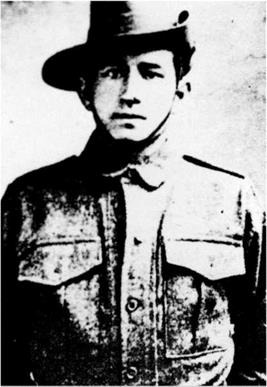
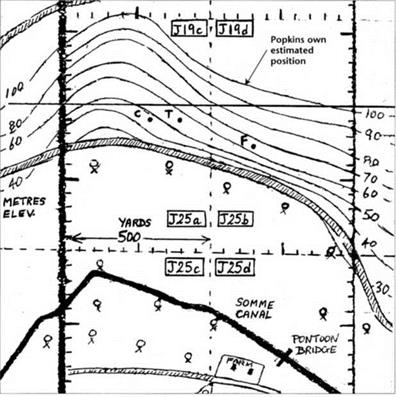
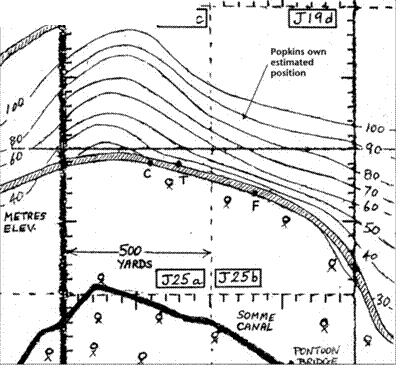 These positions, if true, would have had little defensive value.
These positions, if true, would have had little defensive value.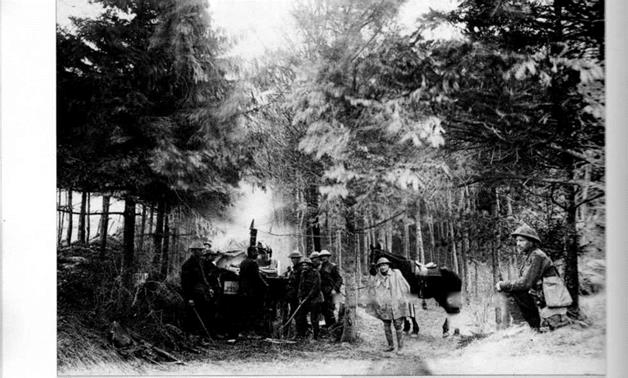 survived the war, and the coincidence is not accidental, he kept a sharp look-out at all times and in all directions. Down to his right nearVaux, he saw three aeroplanes; a Camel, followed by a Triplane — both heading west; then a second Camel, higher up, diving at about a 45° angle to intercept the Triplane. Taking a good look round every few seconds and turning his own Camel as required to be sure that no enemy was sneaking up on him, he watched the show from a front row seat in the Gallery.
survived the war, and the coincidence is not accidental, he kept a sharp look-out at all times and in all directions. Down to his right nearVaux, he saw three aeroplanes; a Camel, followed by a Triplane — both heading west; then a second Camel, higher up, diving at about a 45° angle to intercept the Triplane. Taking a good look round every few seconds and turning his own Camel as required to be sure that no enemy was sneaking up on him, he watched the show from a front row seat in the Gallery.
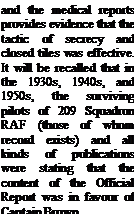 2.
2.





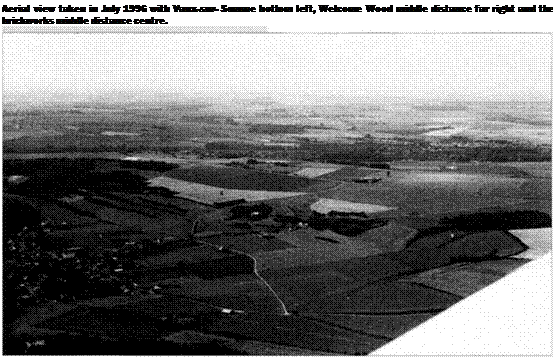
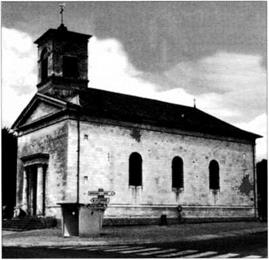
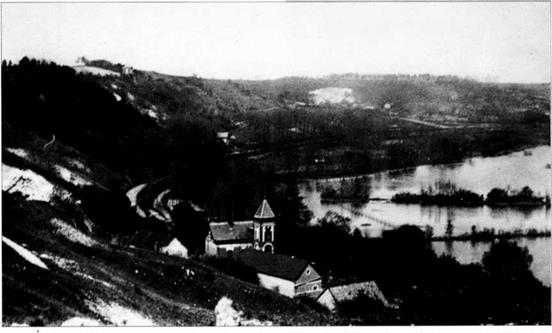
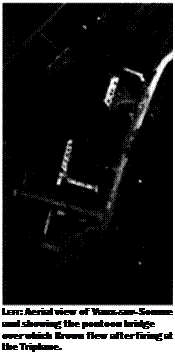
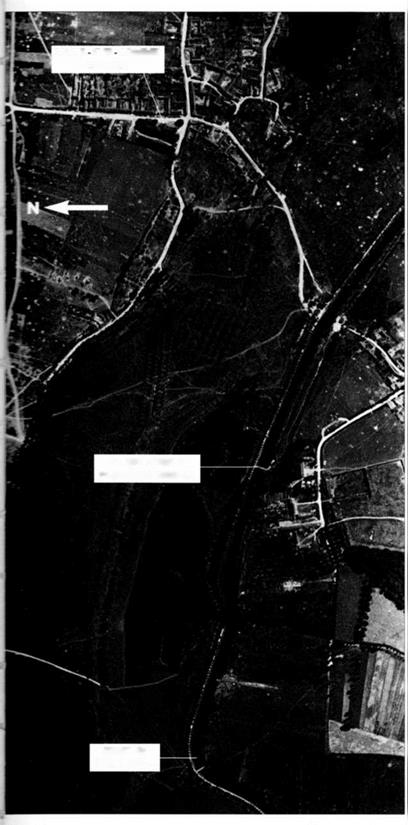 VAUX SUR SOMME
VAUX SUR SOMME
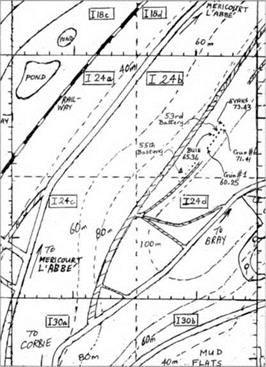
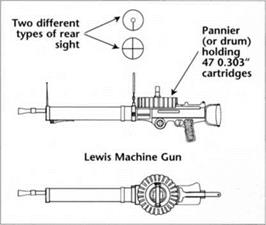


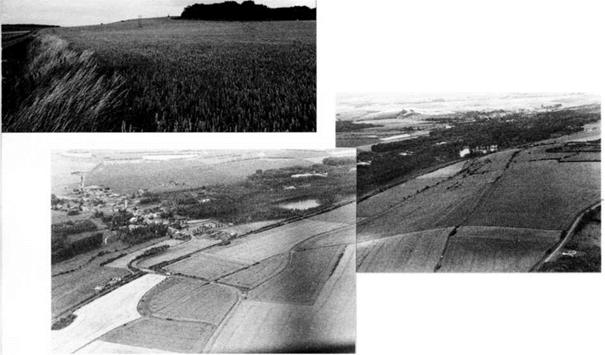 determined had been one of the main reasons JGI group had been called into the area, to help, by clearing the sky. German two-seaters to spot them. If he had seen them, it may have gone through his mind in those last moments that this information was something urgently needed.
determined had been one of the main reasons JGI group had been called into the area, to help, by clearing the sky. German two-seaters to spot them. If he had seen them, it may have gone through his mind in those last moments that this information was something urgently needed.